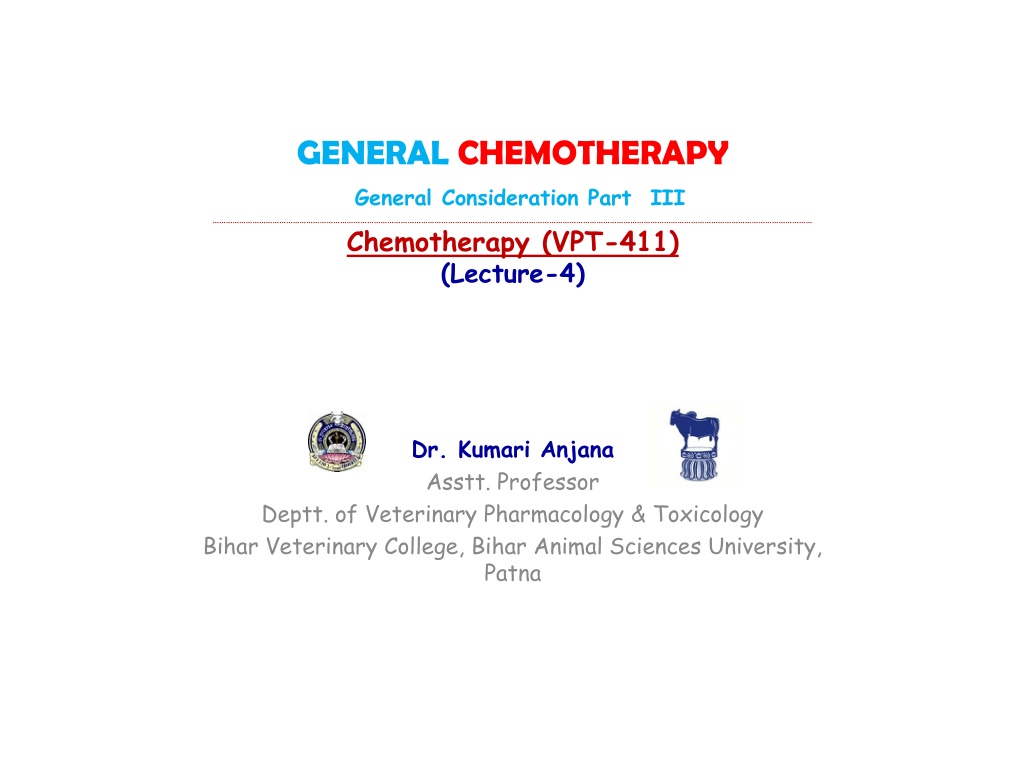Ideal Antimicrobial Agents and Antimicrobial Classification Overview
This lecture on general chemotherapy outlines the properties of ideal antimicrobial agents, emphasizing selective and effective activity, bactericidal action, non-toxicity, and more. It also covers the classification of antimicrobials based on chemical structure, including sulfonamides, diaminopyrimidines, quinolones, -lactam antibiotics, tetracyclines, and various other classes crucial in combating infections.
Download Presentation

Please find below an Image/Link to download the presentation.
The content on the website is provided AS IS for your information and personal use only. It may not be sold, licensed, or shared on other websites without obtaining consent from the author. Download presentation by click this link. If you encounter any issues during the download, it is possible that the publisher has removed the file from their server.
E N D
Presentation Transcript
GENERAL CHEMOTHERAPY General Consideration Part III Chemotherapy (VPT-411) (Lecture-4) Dr. Kumari Anjana Asstt. Professor Deptt. of Veterinary Pharmacology & Toxicology Bihar Veterinary College, Bihar Animal Sciences University, Patna
Content of the chapter Properties of ideal antimicrobial agents. Classification of Antimicrobials Principle of chemotherapy
Properties of ideal antimicrobial agents It should exhibit selective and effective antimicrobial activity. It should be bactericidal rather than bacteriostatic. Bacteria should not develop resistance to the drug. It should be effective in the presence of body fluids and exudates.
Bactericidal levels of the drug should be reached in the blood, tissues and C.S.F. immediately and maintained periods. for prolonged The drug should be non toxic. Drug bactericidal concentration. should be excreted in urine in
Classification of Antimicrobials
On the basis of Chemical structure 1. Sulfonamides and related drugs: Sulfadiazine and others, Sulfones- Dapsone (DDS), Paraaminosalicylic acid (PAS). 2. Diaminopyrimidines: Trimethoprim, Pyrimethamine. 3. Quinolones: Nalidixic acid, Norfloxacin, Ciprofloxacin, Gatifloxacin, etc.
4. -Lactam antibiotics: Penicillins, Cephalosporins, Monobactams, Carbapenems. 5. Tetracyclines: Oxytetracycline, Doxycycline, etc. 6. Nitrobenzene derivative: Chloramphenicol. 7. Aminoglycosides: Streptomycin, Gentamicin, Amikacin, Neomycin,etc. 8. Macrolide antibiotics: Erythromycin, Clarithromycin, Azithromycin, etc.
9. Lincosamide antibiotics: Lincomycin, Clindamycin. 10. Glycopeptide antibiotics: Vancomycin,Teicoplanin. 11. Oxazolidinone: Linezolid. 12. Polypeptide antibiotics: Polymyxin-B, Colistin, Bacitracin, Tyrothricin. 13. Nitrofuran derivatives: Nitrofurantoin, Furazolidone. 14. Nitroimidazoles: Metronidazole, Tinidazole, etc.
15. Nicotinic acid derivatives: Isoniazid, Pyrazinamide,Ethionamide. 16. Polyene antibiotics: Nystatin, Amphotericin-B, Hamycin. 17. Azole derivatives: Miconazole, Clotrimazole,Ketoconazole, Fluconazole. 18. Others: Rifampin, Spectinomycin, Sod.fusidate, Cycloserine, Viomycin, Ethambutol, Thiacetazone, Clofazimine, Griseofulvin.
On the basis of the mechanism ofaction 1.Inhibitors of cell wall synthesis: Penicillins, cephalosporins, bacitracin, vancomycin, novobiocin. 2. Cause leakage from cell membrane: Polymyxin, Nystatin, Amphotericin B, Polyene antibiotics, Colistin, Cationic detergent & Aminoglycosides. 3. Inhibits of protein synthesis: Tetracyclines, Chloramphenicol, Erythromycin, Tylosin (Macrolides) 4. Cause misreading of m-RNA code and affect permeability: Aminoglycosides
Targets of Antimicrobial Agents Source: Mirobiology: A clinical Approach
5. Inhibit DNA Gyrase: Fluoroquinolones 6. Interfere with DNA function: Rifampin, Metronidazole 7. Interfere with DNA synthesis: Acyclovir, Zidovudin 8. Interfere with intermediary metabolism: Sulfonamides, sulfones, PAS, Trimethoprim, Pyrimethamine, Ethambutol.
Classification on the basis of Type of organism/Therapeutic uses Antibacterial Penicillins, Aminoglycosides, Erythromycin, etc. Antifungal Griseofulvin, Amphotericin B, Ketoconazole, etc. Antiviral Acyclovir, Amantadine, Zidovudine, etc. Antiprotozoal Chloroquine, Pyrimethamine, Metronidazole, Diloxanide. Anthelmintic Mebendazole, Pyrantel, Niclosamide,Diethyl carbamazine, etc.
Classification on the basis of spectrum of activity Narrow Spectrum :- Effective against a limited group of bacteria. i) Gram positive :- Penicillin G, erythromycin, lincomycin, bacitracin etc. ii) Gram negative:- Streptomycin, gentamycin, polymyxin B etc. Broad spectrum :- Effective against both Gram positive & Gram negative bacteria E.g.:- Tetracyclines, chloramphenicol, fluoroquinolones, Sulfonamide.
Classification on the basis of Type of action Bacteriostatic: Cause suppression of bacterial growth and multiplication. Eg.Sulphonamides,tetracyclines, erythromycin, chloramphenicol. Bactericidal: Cause death of bacteria. Eg.Penicillin,cephalosporins, streptomycin, kanamycin, colistin, bacitracin etc.
Classification on the basis of Source Fungal Origin: Penicillin, Cephalosporin and Griseofulvin. Bacterial Origin: Bacitracin, Polymyxin, Colistin, tyrothricin. Actinomycetes Origin: Streptomycin, tetracyclines, chloramphenicol, Macrolides
Principle of chemotherapy The basic principle of chemotherapy is the selective toxicity i,e. the drug should selectively inhibit or kill the disease causing pathogenic organism. Chemotherapy must be rational and needs to be supported by either a clinical or microbiological diagnosis to identify the pathogenic organisms. Characterization of the pathogens including its sensitivity to an AMAs is essential.
Selection of an appropriate drug based on Pathogenic organism, Patient factors and Drug factors. The drug should be used in proper time, by proper route, at appropriate dose rate and for a proper duration. Attainment chemotherapeutic agent for a sufficient period at the site of infection (tissue or body fluid) is very important. of effective concentration of a


























